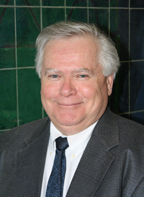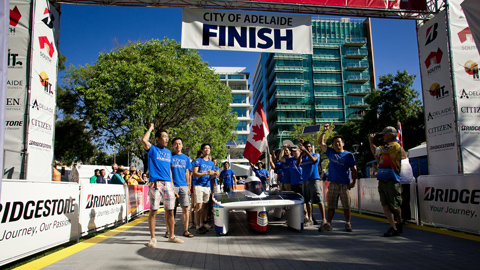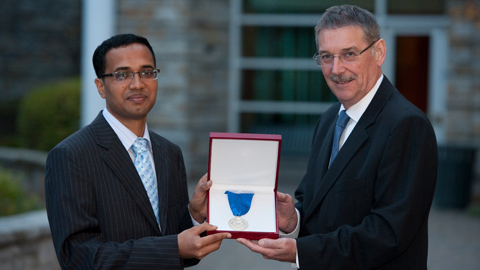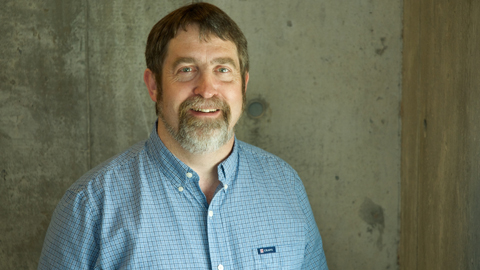
U of T Engineering Professor Doug Hooton (CivE 7T4, MASc 7T5) is the 2013 Robert E. Philleo Award winner from the American Concrete Institute (ACI).
The award, given by the ACI Foundation Concrete Research Council, honours exemplary teaching, research and service to the profession in the areas of durability of concrete, properties of concrete-making materials and preparation of standards and specifications.
“We are delighted Professor Hooton has been recognized for his outstanding contributions to the integrity of our physical infrastructure,” said Cristina Amon, Dean, Faculty of Applied Science & Engineering. “He is an exceptional leader in improving standards in this field.”
The Department of Civil Engineering professor is one of the country’s top experts in the durability and sustainability of cement and concrete. He has worked for years with industry and government to improve the design, construction and repair of concrete structures.
Hooton, who is currently serving as NSERC/CAC Industrial Research Chair in Concrete Durability and Sustainability, received his award on October 20 at the council’s annual convention in Phoenix.
Hooton also recently received the Frank E. Richart Award, presented by the American Society for Testing and Materials (ASTM) and was inducted as a 2013 Fellow in the Canadian Academy of Engineering (CAE).
 Professor Yu Sun (MIE) has been elected Fellow of the American Society of Mechanical Engineers (ASME). Fellowship is the highest elected grade of membership within ASME, the attainment of which recognizes outstanding engineering achievements and contributions to the engineering profession.
Professor Yu Sun (MIE) has been elected Fellow of the American Society of Mechanical Engineers (ASME). Fellowship is the highest elected grade of membership within ASME, the attainment of which recognizes outstanding engineering achievements and contributions to the engineering profession.
A global leader in the development of micro-nano robotics and device technologies for biomedical, clinical and precision instrumentation disciplines, Professor Sun has invented automated processes for cell manipulation that are impacting clinical cell surgery, clinical diagnostics and genetics. He is a Canada Research Chair in Micro and Nano Engineering Systems, a Fellow of the Canadian Society of Mechanical Engineering (CSME) and a Fellow of the Engineering Institute of Canada (EIC). He currently holds an NSERC E.W.R. Steacie Memorial Fellowship.
“I am delighted that Professor Yu Sun has been recognized by his colleagues of the American Society of Mechanical Engineers,” said Professor Jean Zu, Chair of the Department of Mechanical & Industrial Engineering. “This honour attests to his ongoing recognition as a leader in his field. On behalf of the Faculty, I congratulate him on this notable distinction.”
The ASME Board of Governors confers the Fellow grade of membership on exceptional candidates as nominated by their peers.

U of T’s Blue Sky Solar Racing team is heading home after a successful eighth-place overall finish, and second among North American teams, in the 2013 Bridgestone World Solar Challenge, a gruelling 3,021-kilometre race for solar-powered cars across Australia from Darwin in the north to Adelaide in the south.
The Blue Sky team achieved its goal of finishing in the top 10 among the 23 teams. Blue Sky’s car, B7, completed the race, which ran down the Stuart Highway through some of Australia’s most isolated countryside , in 45 hours and 38 minutes, achieving an average speed of 65.71 km/hour.
Team members are on their way home from Australia and unable to comment on the experience, but according to their blog the race didn’t always go smoothly. There were minor glitches such as steering wheel problems. And on day 4 of the 6-day race, Blue Sky Solar’s support trailer jack-knifed and a crate containing crucial supplies fell off. Blue Sky Solar was helped out by the University of Calgary team which stopped and lent a hand to their U of T competitors.
Blue Sky Solar has been building and racing solar cars since 1996, when a small group of Mechanical and Electrical & Computer engineering students formed the Advanced Solar Electrical Vehicle Program. The team includes students from different faculties, but is mostly comprised of Engineering students. Built and driven entirely by students, B-7 features the latest advancements in photovoltaic technologies, a brand new aerodynamic design and improved vehicle dynamics systems, weighing about 20 per cent less than its predecessor, Azure, which placed 24th out of 37 teams in the 2011 World Solar Challenge.
“We are all very proud of Blue Sky Solar,” said Cristina Amon, Dean, Faculty of Applied Science & Engineering. “To go against the best teams in the world and finish in the top 10 is a testament to their hard work, ingenuity and drive. I congratulate all the members of the team on this tremendous achievement.”
Blue Sky Solar competed in the Challenger class race, which was won by a team from the Netherlands, which completed the race in just 33 hours.
For full race results, visit the World Solar Challenge website.
The launching of new start-up company Interngration is the most recent success of U of T Engineering’s Entrepreneurship Hatchery. It went live officially on Tuesday, October 15, 2013.
Started by recent Electrical and Computer Engineering grads Anirudh Ganti (ElecE 1T3), Hargun Suri (CompE 1T3) and Ian Xiao (ElecE 1T3), Interngration is a software service designed to help match students to employers for potential internships and employment opportunities.
The idea was inspired by the chaos and the frustration with long lines and crowds at job fairs, says Ganti. He and his two partners came up with an idea to alleviate that problem, and on the advice of a professor, took it to the Hatchery. There, they received advice and guidance on how to develop the idea into a business, and had mentors who had started up businesses themselves share their experiences.
It was a steep learning curve, but the three learned about business plans, testing the viability of the idea with metrics, adjusting the idea for the real world, how to approach potential investors and much more. Then, of course, there was creating the framework which took a lot of time. It was a steep learning curve, says Ganti.
The end product is a web application that is free for students to use, but supported by businesses that use it in their quest to find talent for their companies. At this point, Interngration is limited to small companies and start-ups – places that are often overshadowed in large job fairs, Ganti said.
The project attracted the attention of the City of Toronto which presented Suri with the International Student Excellence Award in the entrepreneurship category.
“Interngration is a terrific example of what the Hatchery is all about,” said the Hatchery’s executive director, Joseph Orozco. He is also Adjunct Professor of the Centre for Management of Technology and Entrepreneurship (CMTE).
In fact, the new start-up is one of two success stories to come out of the Hatchery in its first year of operation. The other is Cytospan, a new company based around a technology to better measure the life span of living cells.
The Hatchery is open to students from all disciplines at the U of T. But there is a requirement that at least one engineering student be on each team. The Hatchery fosters multidisciplinary teamwork, Professor Orozco says.
“The Hatchery is about defining business models, creating viable products, finding opportunities that are real and hopefully generating revenue and jobs,” he says.
There is little that can inspire someone to take their first steps towards actual entrepreneurship better than a helping hand that offers expertise and guidance.

Dr. Muhammad Zulfiker Alam, a post-doctoral fellow in The Edward S. Rogers Sr. Department of Electrical & Computer Engineering, has been announced as the 2013 recipient of the Douglas R. Colton Medal for Research Excellence. Alam received the award at a ceremony Tuesday evening in Gatineau, Que. at CMC Microsystems’ 2013 Annual Symposium.
The Douglas R. Colton Medal for Research Excellence recognizes excellence in research leading to new understanding and novel developments in microsystems and related technologies, such as photonics/optoelectronics, microelectromechanical systems (MEMS), microelectronics, microfluidics and embedded software, or the application of microsystems and related technologies in Canada. The annual award includes a medal and a monetary prize of $4,500 and is presented by CMC Microsystems.
Alam’s doctoral work, co-supervised by Professors Mo Mojahedi (ECE) and Stewart Aitchison (ECE), focused on theory and applications of hybrid plasmonic waveguides; specifically, on overcoming the limitations of plasmonics posed by high loss. Alam’s most significant contribution was the first proposal of the hybrid plasmonic waveguide, which utilizes the plasmonic confinement property but does not suffer large loss— this has been widely accepted as one of the most promising plasmonic waveguides proposed to date.
Alam’s PhD thesis resulted in 13 publications in high-impact journals, 20 conference publications and eight invited talks.

Ever wonder about the forces of nature, how they work and how life manages to survive amongst these forces? U of T Professor Bryan Karney from Civil Engineering and Engineering’s Cross-Disciplinary Programs Office is launching the department’s first Massive Open Online Course (MOOC), a free, multimedia online course open to anyone who is interested.
Our Energetic Earth explores the dynamics of the planet. It covers topics as diverse as what causes wind and the ocean currents, to what drives thunderstorms and how energy from sunlight is converted to thermal energy. It also addresses why, in the cold vastness of space, Earth’s surface is able to support life. Course content will give students a better sense of the complexity, challenges and wonder of living on such an energetic planet.
A MOOC allows for the participation of large numbers of people in non-credited courses. It includes videos, reading material, problem sets and interactive forums which include both students and instructors. Anyone can enrol.
Professor Karney explains more about the course.
Why choose this topic for Engineering’s first MOOC?
A few years back, we created a course that covered energy and thermodynamics. Instead of being about exploiting sources, it looked at the energy that is around us as part of a dynamic Earth. We looked at understanding the forces behind hurricanes, tsunamis and more. The first year, the course attracted 35 students, but within five years that number jumped to 550. There is a huge interest in this topic.
What will students get out of it?
Students will become part of the discussion about renewable energy and sustainability, and this course gives them a ‘big picture’ view. This gives them something that’s applicable to the world and not just machines.
Often we stop noticing some of the extraordinary things going on around us – in a windstorm, the flash of lightning or when the ocean waves are crashing. What happens around us is amazing, and it’s even more special if we understand the causes.
What triggered you to offer a course in this format?
I like going beyond lecturing and exploring other creative ways to teach, including using the Internet and social media. A course delivered in this format has the ability to reach a huge audience and is available to people who otherwise would not have heard of this topic.
What do you hope to accomplish?
I like the idea of reaching a wider audience and developing new materials we can use in conventional settings too. What I hope students will get from this course is the ability to participate in debates and discussions about energy in a more informed and broader way.
Classes start October 28, 2013, and course length is six weeks. Sign up for the course here: Our Energetic Earth
Professor Karney is known for his enthusiastic teaching style. He was one of 10 lecturers selected for Television Ontario’s (TVO) Best Lecturer Competition in 2007, and in 2009 received the Northrop Frye award for excellence in combining teaching and research. His research focuses on water resources and energy systems.
